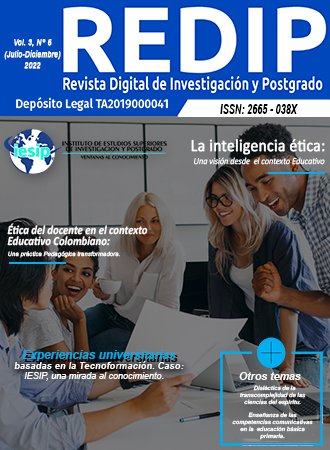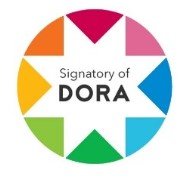Open and distance learning
A model revaluedin the pandemic and in constant change
DOI:
https://doi.org/10.59654/1yrwt133Keywords:
Distance Education, Open Education, Pandemic, Open Learning, Open Educational Resources.Abstract
Open and distance learning is a model that has elements of great strength and evolves every day as new developments are made in systems, methods and technologies that facilitate the learning process. Open educational resources (OER), open licences and the technical openness of resources have generated an open pedagogy that is becoming more widespread through the use of new technological tools available on the Internet. Proof of this progress is that in the Covid-19 pandemic, open and
distance education through digital distance education has been the support for institutions that developed traditional education, which brought with it remote emergency learning. Precisely, the purpose of the article is to make a hermeneusis to open and distance education as a model revalued in the pandemic and which is constantly changing.
Downloads
References
Aureliano, F. E. B. S., & Queiroz, D. E. de. (2022). Astecnologias digitais como recurso pedagógicodo ensino remoto: implicações na formação continuada e nas práticas docentes. In SciELO Preprints. https://preprints.scielo.org/index.php/scielo/preprint/view/3851/7208
Betancourt, M.C., Celaya, R. y Ramírez, M.S. (2014). Prácticas educativas abiertas y apropiación tecnológica: el caso de la Comunidad Latinoamericana Abierta y Regional de Investigación Social y Educativa (CLARISE). Revista de Universidad y Sociedad del Conocimiento (RUSC). 11(1), 4-17. http://doi.dx.org/10.7238/rusc.v11i1.1794.53.
Butcher, N. (2015). Guía Básica de Recursos Educativos Abiertos (REA). Asha Kanwar (COL) y Stamenka Uvalic ́-Trumbic ́ (UNESCO). Organización de las Naciones Unidas para la Educación, la Ciencia y la Cultura. https://unesdoc.unesco.org/in/documentViewer.xhtml?v=2.1.196&id=p::usmarcdef_0000232986&file=/in/rest/annotationSVC/DownloadWatermarkedAttachment/attach_import_508325db-1252-4242-9394-0241b836d17e%3F_%3D232986spa.pdf&locale=es&multi=true&ark=/ark:/48223/pf0000232986/PDF/232986spa.pdf#2800_14_S_Basic%20Guide%20OER_Int.indd%3A.144121%3A1155
Educación 3.0 (s.f). Recursos Educativos Abiertos (REA) gratis. https://www.educaciontrespuntocero.com/recursos/recursos-educativos-abiertos-rea-gratis-para-todos/
GARA. (2014). Creative Commons alcanza los 882 millones de licencias en 2014. https://www.naiz.eus/es/hemeroteca/gara/editions/gara_2014-12-16-06-00/hemeroteca_articles/creative-commons-alcanza-los-882-millones-de-licencias-en-2014
García, A. L. (2021). COVID-19 y educación a distancia digital: preconfinamiento, confinamiento y posconfinamiento. RIED. Revista Iberoamericana de Educación a Distancia, 24(1), 9-25. https://www.redalyc.org/jatsRepo/3314/331464460001/331464460001.pdf
Glasserman, L. D. (2012). Documentación de Experiencias de una Práctica Educativa Abierta (PEA) en un Curso de Educación Superior”. REICE. Revista Iberoamericana sobre Calidad, Eficacia y Cambio en Educación, 10 (2), 201-211. http://www.rinace.net/reice/numeros/arts/vol10num1/art13.pdf
Hilton, J. l., Wiley, D., Stein, J., & Johnson, A. (201 O). The four 'R's of openness and ALMS analysis: Frameworks for open educational resources. Open Learning: The Journal of Open and Distance Learning. http://www.tandfonline.com/doi/abs/10.1080/02680510903482132
Hodges, C., Moore, S., Lockee, B., Trust, T y Bond, A. (2020). La diferencia entre la enseñanza remota de emergencia y el aprendizaje en línea. En A. Cabrales et al (Editores) Enseñanza de emergencia a distancia: textos para la discusión. The Learning Factor.
Lara, J. C. y Rossini, C. (2014). La información y el conocimiento abierto en el contexto de la cooperación multilateral: Aspectos clave para la revisión del Acuerdo Regional No. 7 de ALADI. Cuadernos de Discusión de Comunicación e Información. Organización de las Naciones Unidas para la Educación, la Ciencia y la Cultura - Oficina Regional de Ciencias de la UNESCO para América Latina y el Caribe, Oficina de UNESCO en Montevideo. https://unesdoc.unesco.org/in/documentViewer.xhtml?v=2.1.196&id=p::usmarcdef_0000230986&highlight=aprendizaje%20abierto&file=/in/rest/annotationSVC/DownloadWatermarkedAttachment/attach_import_796e223e-b674-4048-b7bf-69b26f8bdb2b%3F_%3D230986spa.pdf&locale=es&multi=true&ark=/ark:/48223/pf0000230986/PDF/230986spa.pdf#CDCI2-Aladi-ES-Ojo.indd%3A.29220%3A259
Ley Orgánica de Educación. (2009). Gaceta Oficial de la República Bolivariana de Venezuela, Extraordinario agosto de 2009. Imprenta Nacional y Gaceta Oficial.
Miao, f., Mishra, s., Orr,D. y Janssen, B. (2020). Directrices para la elaboración de políticas de recursos educativos abiertos. Organización de las Naciones Unidas para la Educación, la Ciencia y la Cultura (UNESCO).
MOOC. (s.f). ¿Qué es un Mooc? https://mooc.es/que-es-un-mooc/
Open Educational Quality Initiative. (s.f). The OEP Best Practice Clearing House. http://www.oer-quality.org/clearinghouse/browse/
Reig, H. D. (2012). Sociedad aumente y aprendizaje. #IBERTIC. Video. https://www.youtube.com/watch?v=ci3EeZRXVDM.
Silva, S. L. R. Da., Andrade, A. V. Ch. De y Brinatti, A. (2020). Ensino Remoto Emergencial. Ed. Dos autores, http://www1.fisica.org.br/mnpef/sites/default/files/anexosnoticia/EnsinoRemotoEmergencial_SilvaAndradeBrinatti.pdf
Wiley, D. (2014a). Open content. Pressbook. https://openedreader.org/chapter/open-content/
Wiley, D. (2014). Defining the "open" in open content and open educational resources. http://opencontent.org/definition/
Wiley, D. (2015). Open pedagogy: The importance of getting in the air. [Blog post]. http://opencontent.org/blog/archives/3761
Zambrano, F. F. J. (2017). Sociedad del conocimiento y las TEPs. INNOVA Research Journal, 2(10), 169-177. https://dialnet.unirioja.es/servlet/articulo?codigo=6183861
Downloads
Published
Issue
Section
License
Copyright (c) 2022 Revista Digital de Investigación y Postgrado

This work is licensed under a Creative Commons Attribution-NonCommercial-ShareAlike 4.0 International License.
Esta licencia permite a los reutilizadores distribuir, remezclar, adaptar y desarrollar el material en cualquier medio o formato únicamente con fines no comerciales, y solo siempre que se atribuya al creador. Si remezclas, adaptas o construyes sobre el material, debes licenciar el material modificado bajo términos idénticos. CC BY-NC-SA incluye los siguientes elementos:
![]() POR: se debe dar crédito al creador.
POR: se debe dar crédito al creador.![]() NC: Sólo se permiten usos no comerciales de la obra.
NC: Sólo se permiten usos no comerciales de la obra.![]() SA: Las adaptaciones deben compartirse en los mismos términos.
SA: Las adaptaciones deben compartirse en los mismos términos.











